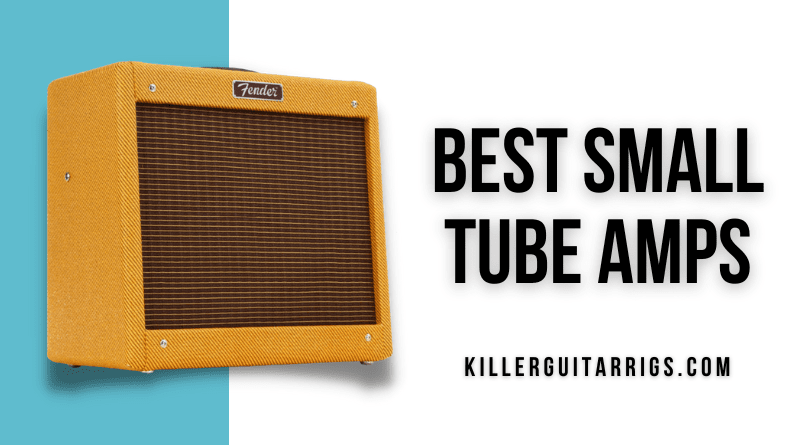Tube amplifiers are as popular today as they’ve ever been, but one thing about them has never changed – power management. Depending on your use case, bigger isn’t always better, and it’s for this reason that most players would rather have a 1- to 20-watt tube amp for home or studio use than a 200-watt stack.
With a small amp, you can more easily break up the sound into overdrive at reasonable volumes, making them much more useful for the average player (who doesn’t want to have to install noise cancelling curtains to appease the neighbors). In addition, smaller amps are far more portable, making it easier to take them to jam sessions or gigs. With that in mind, we’ve put together this KillerGuitarRigs Review of the 7 Best Small Tube Amps.
We tested every amp with the same guitar, a Fender Mexican Standard Stratocaster. To test each amp’s ability to take pedals, we used the same simple pedal board, featuring an Ibanez Tube Screamer and a Fender Bubbler chorus pedal.
If you’re in the market for the best small tube amp, you’ll definitely want to keep on reading.
Read more about our review process.
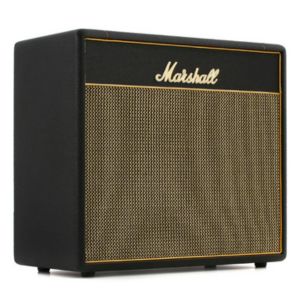
Marshall SV20C Studio Vintage
Features: Celestion V-Type speaker, 3 Band EQ, Built in attenuator
Benefits: Superb Plexi tones, Great low volume tones, Excellent sound shaping
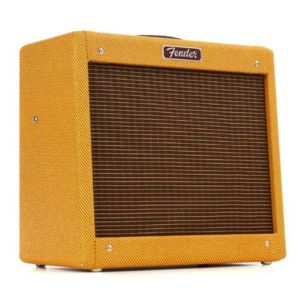
Fender Pro Junior IV
Features: 2 Knob control panel, Lacquered tweed cover, Jensen P10R speaker
Benefits: Retro looks, Simple operation, Great cleans
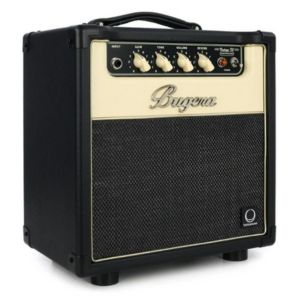
Bugera V5 Infinium
Features: Tube Life Multiplier technology, Light weight, Built in attenuator
Benefits: Crunch at bedroom levels, Excellent portability, Long lasting tubes
Contents
Our Top 3
We selected the Fender Pro Jr IV as our top pick. It delivered excellent performance at an attainable price and is well regarded as one of the best studio and practice amps ever made.
Our best value choice went to the Bugera V5 Infinium. We were amazed at what Bugera had managed to accomplish for such a low price. It was extremely well-made and surprisingly well-equipped for the money.
We ended up giving our Editor’s Choice to a giant in the world of small amps, the Marshall SV20C Studio Vintage. When money is no obstacle, they don’t get any better than this. It gave us real Plexi tones at useable volumes, and that alone was worth the price of entry.
Individual Reviews
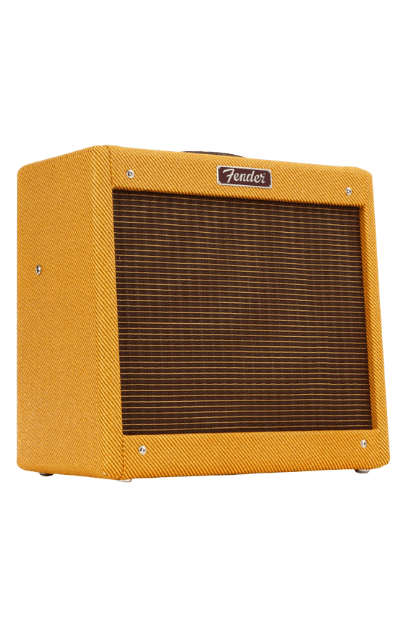
Fender Pro Jr IV
Retro looks and some of the best clean performance from any small tube amp.
This little Fender is a fantastic amplifier. It’s simple to use delivers glassy cleans and the tweed cover looks sensational. It’s as at home in the studio as it is on stage, but it also makes a great home practice amp, too.
The Fender Pro Junior IV (full review here) is a continuation of one of the brand’s most beloved models. It comes with 15 W of power by way of a pair of 12 a X7 preamp tubes and 2EL 84 power tubes. It was equipped with 1 Jensen 10” P10R speaker.
We started our test with a dry signal to see how it stood up on its own without pedals. Dialing in the tone was a very simple process due to the fact that the Pro Junior IV has such a simple control layout; one input with a single volume control and a master tone knob.
Despite only being 15 watts, this Fender got very loud very quickly. In fact, by the time the volume was at noon, we exceeded comfortable bedroom levels. Even though it was pushing some serious air, we didn’t even get a slight break up until we moved the volume to eight, at which point we got some gorgeous mild overdrive.
It had impressive responsiveness, too. Once we’d reached the point of breakup, just by switching to a gentler attack, it cleaned up beautifully. Similarly, by rolling the volume on the guitar itself to around 7, we got clean tones with the amp cranked to 10.
Because it was such a strong, clean performer, the Pro Jr IV took pedals like a champ, and really let the tone of the pedals shine through without losing any of its own character.
We found that the amp itself was built like a tank, with no rattles or unusual noises, even when cranked.
Verdict: The Fender Pro Jr IV is one of the most popular tube amps on the market. It’s built to last, and it serves up some of the best clean tones you’ll find anywhere. When pushed hard, it produces some gorgeous breakup. And because it takes pedals so well, you don’t need to max the volume in order to get great overdrive.
- Fantastic looks
- Great cleans
- Takes pedals well
- Handle is prone to failure
- No attenuator

Bugera V5 Infinium
Classic styling and incredible value for money.
Bugera’s baby tube amp delivers excellent performance in a compact package. It’s extremely well equipped for the price, and even features an attenuator, meaning you can dial down the power, and dial up the fun without blowing out your windows.
Bugera is a Behringer brand, which is the first giveaway as to their budget focus. The Bugera V5 Infinium was powered by a single 12AX7 preamp tube and one EL84 power tube, delivering 5 watts of total class-A power through its 8” Turbosound speaker (full review here).
With a dry signal, we set the gain to low, the tone to noon, and the reverb to zero. We then worked the volume knob from zero all the way to 10, finding we had tons of clean headroom. Adding some gain changed the story, and quickly turned this cute vintage looking amp into a snarling beast.
Switching the attenuator down to 1 watt increased the fun even further. We even managed to get some metal tones without the aid of the pedal board, all at reasonable household volume.
The reverb was surprisingly organic sounding, too, making it an extremely useable function that further added to the already excellent value.
In addition to being a strong performer as a standalone amp, it also played nicely with pedals. It didn’t mask any of the FX in the full 5W mode, even at higher volumes.
We had zero concerns about the build quality – it was good and solid, with nice leather look Tolex and a cool retro-looking, off-white panel. The dials all moved nicely and the pots gave a good sweep, too.
Verdict: The Bugera V5 Infinium was tons of fun to play with. It may not have the brand recognition of Fender or Marshall, but it certainly kept up performance-wise. It delivered a range of great tones across a number of music styles, and would make an excellent practice amp, or even a good budget recording amp.
- Power attenuator
- Great natural overdrive
- Long tube life
- No 3 band EQ
- No line out option
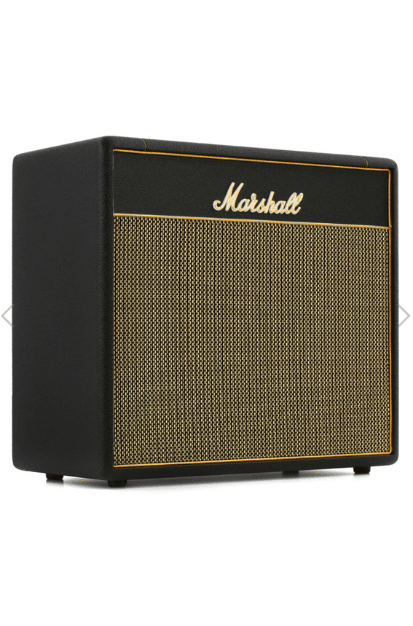
Marshall SV20C Studio Vintage
A full featured, premium tube amp for fans of the famous Plexi sound.
With this Marshall you’re getting a portable version of the iconic Super Lead from the late 1950s, better known as the Plexi. It delivers the same iconic tones that defined an entire generation of music, all at manageable levels.
While it technically slots into the small amp category, the Marshall SV20C Studio Vintage is still a behemoth (full review here). It was powered by 3 12AX7 preamp tubes and 2 EL34 power tubes, giving us crazy amounts of power to push through the 10” Celestion V type speaker. It had 2 channels, and 2 inputs per channel, making it an extremely versatile amp.
When played with a direct input from the guitar, we had an easy time dialing in the perfect tone. It had a full 3 band EQ, plus a presence control. It gave us some amazing cleans, with tons of headroom in the clean channel, and when played from the lead channel, we got everything from a slight overdrive to big chunky distortion.
Volume-wise, the SV20C was seriously impressive. With all 20 watts engaged, it was incredibly loud. When the 5-watt mode was engaged, it was still plenty loud, but it let us get the breakup going much sooner.
It responded well to playing dynamics both in full-power mode and in reduced power, although the effect was far more noticeable in the 5-watt mode. A gentler attack quickly killed the crunch, bringing it back to crystalline clears without any settings adjustment. It was the same story when rolling back the master volume on the guitar, too.
Both the Tube Screamer and the Bubbler performed brilliantly through the Marshall. It complimented them perfectly, and we almost feel like the amp and pedals worked synergistically to produce an incredible array of tones.
This amp was stunning to look at, and being one of Marshall’s more premium product lines, it was incredibly well made, too. Everything felt properly secured, and there were no rattles or squeaks, either.
Verdict: The Marshall SV20C Studio Vintage was an outstanding amplifier in all areas of our testing. Great build quality, tones, and versatility were all there. It did cleans well, which is unusual for a Marshall, and of course, when we wanted it to growl, it quickly obliged.
- Plexi tone
- Excellent speaker
- Unmatched build quality
- Expensive
- Very loud for home settings, even in 5 watt mode

Vox AC4
Iconic British tone conveniently packaged for home and studio use.
Fans of the British invasion will no doubt love this Vox tube amp. It’s capable of delivering all of the classic Vox tones, including the famous chime, and the raucous top boost. It’s simple to use, and brings with it bulletproof build quality and reliability.
The Vox AC4 is the epitome of tube amp fun. With 4 watts of power on tap, it had plenty of volume, but at the same time, it didn’t take too much to saturate the 2 12AX7s and the EL84 into a beautiful, crunchy overdrive. The tubes drove a Celestion Custom VX12, which we think was overkill for a 4-watt model. If it had a 10” speaker instead, we think the tones might have been just a little more focused.
Direct from the guitar, the AC4 sounded exactly how you’d think a Vox amp would. It was exceptionally sparkly when played clean. Power was quite manageable, as we were able to keep the tone clean pretty much all the way through the volume range simply by keeping the gain to a minimum.
With the gain pushed anywhere between 10 and 2 o’clock, it got nice and crunchy, although anywhere beyond that, it started to become muddy. As briefly mentioned, we think it’s possible that a different speaker would help with this.
The dynamics were spot on with this Vox. With soft styles like fingerpicking, it stayed chimey, even with a bit of gain dialed in. When we played harder, it quickly broke up again, just as it would on one of this amp’s big brothers like the AC30.
It didn’t take pedals quite as well as some of the other models on test, but as we established, there was little headroom and this made it difficult to avoid coloring the tone of the pedals.
The AC4 was otherwise a rock-solid amplifier. It was very well made and had the sturdiest handle in the entire roundup. Its tall, narrow design did make it look a little like a box fan, and it was actually quite easily knocked over, but it was definitely built to take a few knocks.
Verdict: Fans of the Vox sound will definitely appreciate the Vox AC4. It delivers the classic tones that the brand is known for in an easily manageable package. It works well for recording, but it’s best suited to home practice and jam sessions in our opinion.
- Cool styling
- Great crunch
- Excellent responsiveness
- Easily knocked over
- Muddy with too much gain

Supro Delta King 10
Authentic blues tones and awesome styling.
This amp is all about delivering classic bluesy tones with organic overdrive and an authentic feel. It’s undeniably cool, and definitely, a beautifully made piece of kit, with high end features at a surprisingly affordable price.
We really loved the Supro Delta King 10. This 5-watt tube amp really oozed cool, and gave us some fantastically gritty tones courtesy of its 12AX7 preamp tube, and the 6V6 power tube. It made use of a Supro 10” speaker, which we found performed well across the board.
With an amp like this, it’s important to understand the limitations. Having previously tested the larger, more powerful version of this amp, we knew that headroom would be extremely limited, and we weren’t wrong. Getting useful cleans was quite difficult, as the amp wanted to break up at relatively low volumes.
If you choose to look at this as a positive, then the Delta King 10 was capable of some fantastic overdriven tones at bedroom levels, especially with the Pigtronix FAT mode engaged.
One of the coolest things about the DK10 (besides the styling) was that it came with a genuine spring reverb. It sounded fantastic when playing surf rock, and really upped the fun factor.
It wasn’t the most responsive amp in the roundup, and sometimes it struggled to adapt to changes in playing dynamics. This is likely due to the fact that it’s an inherently crunchy amp, and clean tones just don’t come naturally to it.
We found that it definitely added a little fuzz to the performance of the pedals, but not so much that they were unrecognizable.
The build quality was fantastic, but at 23 pounds, it was a hefty unit. Still, there was nothing loose. No play or wiggles on any component, and the handle was actually very comfortable.
Verdict: The Supro Delta King 10 is a great choice for players who aren’t too interested in clean headroom, but who do value cool aesthetics and major crunch. The spring reverb was a real highlight, and definitely helped with the authentic vintage tone, and the Pigtronix FAT mode really allowed for easy breakup without having to crank the volume – a must in a small amp.
- Real spring reverb
- Cool retro styling
- Low volume growl
- Heavy
- Can lack responsiveness
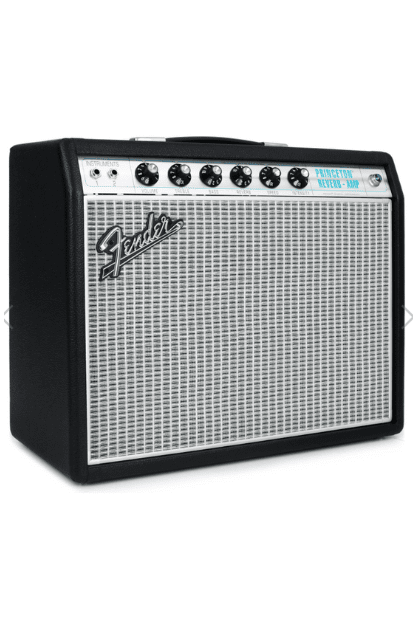
Fender ‘68 Custom Princeton Reverb
An incredible tribute to the legendary Silverface amps of the 1960s.
This amp has truly encapsulated everything good about late ‘60s Fender models, and hot rodded it. You get all the benefits that come with a Fender amp, including the amazing cleans, but with increased touch response and easier breakup at household volumes.
The Fender ‘68 Custom Princeton Reverb delivers vintage tones and looks, but with modern performance and reliability – truly the best of both worlds. It’s a 12-watt model that makes use of 3 12AX7 and a 12AT7 in the preamp stage, and 2 6V6 power tubes with a 5AR4 rectifier – giving this amp some serious firepower. It pushed air with a single Celestion Ten 30, which was a perfectly matched speaker for this amp.
As with the other amps, we started out testing the natural character without pedals. As we expected, even though it was designed to break up earlier than the original Silverface models, it still had mountains of headroom. We got it to break up with the volume just a little past 5, which is pretty early for a Fender.
The built in reverb wasn’t quite as authentic sounding as you’d find on an original Princeton, but it was still a nice feature. It had speed and intensity controls, which did let us dial it in just right.
The hand-wired tubes clearly made a huge difference with the touch response, as we found it to be incredibly sensitive to our style of play. Although, with the volume anything lower than 50%, it did struggle to break up on its own, even with an aggressive attack.
With the pedals in the signal chain, it became a completely different animal. The Tube Screamer gave some subtle, organic, saturated tones even at bedroom volumes, which flipped the script and made it a much more usable amp. One thing we were impressed with was the clarity of this amp. Even when cranked, our chorus effect stayed sharp and added a ton of flavor to the tone.
Build quality was superb, with everything screwed down tight and no rattles or shaking parts. It also came with a 2-button footswitch.
Verdict: The Fender ‘68 Custom Princeton Reverb is a great choice for players who love the ‘60s Fender sound, but who aren’t willing or able to fork out the many thousands that the originals command today. It delivered some great tones with and without pedals, although it’s still extremely loud before breakup starts to happen. Those concerned about disturbing others should consider that fact carefully.
- Original ‘60s styling
- Huge headroom
- Excellent clarity
- Overdrive is difficult to achieve at bedroom levels
- No power attenuation
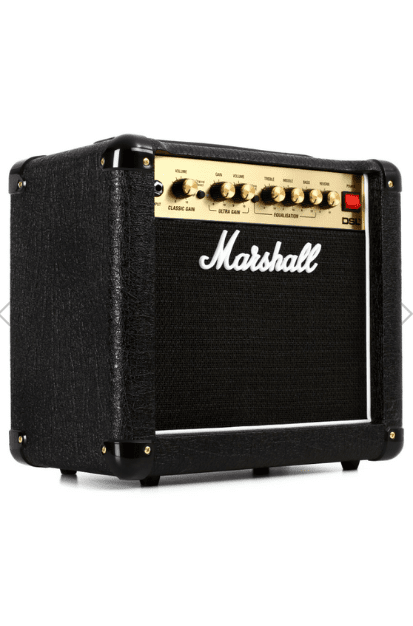
Marshall DSL1CR
A tiny combo version of Marshall’s best selling amp series.
With this tiny combo, you’re getting a genuine Marshall tube amp and all the mega British tones that come with that. With just 1 watt of power, it’s designed for bedroom shredders who want that huge crunch, but without the angry neighbors.
At first glance, the Marshall DSL1CR looks just like one of their inexpensive solid-state practice amps, but look closer and the DSL branding is a dead giveaway that this is something special. It had 2 ECC83 preamp tubes and an ECC82 taking care of the power, driving an 8” Celestion Eight 15 speaker. Amazingly, for such a small amp, it had 2 channels, classic gain and ultra gain – which were just a fancy way to say clean and dirty.
This was one of the amps we were most excited to try for the pure novelty value of playing a 1-watt Marshall tube amp. In the clean setting it was relatively tame, although with the gain anywhere past 11, it was very much in overdrive territory.
In the Ultra Gain channel, we barely broke past 9 o’clock before the tubes were saturated and this thing was screaming. We even had it chugging with some fantastic metal tones at tolerable bedroom volumes.
The 3-band EQ was a great feature, especially considering the size of the amp. It was nice to be able to shape our tone the way we wanted, something we couldn’t do on every amp in the test.
The biggest downside of this amp was that it didn’t take pedals well at all. With the tube screamer running, it got bogged down and very muddy with anything over moderate gain, which was expected, but disappointing nonetheless. We also found that the chorus got washed out, too.
The build quality was excellent for such a tiny amp, however. It was extremely light weight, and would make the perfect bedroom amp, or even a great studio amp to mic up if you’re looking for pure, organic tube overdrive.
Verdict: The Marshall DSL1CR was about as much fun as you can have with a tube amp. It gave us the chance to push it hard, without offending neighbors or blowing out eardrums, which resulted in some mega Marshall tone. It didn’t take pedals well, but it wasn’t really designed to. If you’re a big pedal user, check out the Pro Jr IV, but if you love the classic, raw Marshall tone, this is your amp.
- Highly portable
- Great studio option
- Huge breakup at low volume
- Poor for pedal use
- Tolex felt a little cheap
How To Choose The Right Amp For You
Small tube amps really do require that you look out for a whole different set of features than if you were looking for a more high-powered option. Keep on reading to learn more about the best features in these pint-size models.
Headroom
Headroom is the measure of how loud your amp gets before it starts to break up into overdrive. The general rule of thumb is that the more power an amp has, the more headroom it has. A 1-watt amp will start to break up at very low volumes, whereas a 20-watt amp will be very loud before it starts to saturate into overdrive.
If you’re looking for an amp that has tons of natural tube driven overdrive, consider a low-powered model from 1 to 5 watts. If you’re a pedal user, you’ll want more headroom, and so a 10- to 20-watt amp will be more suitable.
You can also look at headroom in terms of the style of music you play. If you play clean styles like country, clean amps like Fenders will work well for you. If you play rock or metal, you’ll be much happier with the tones from something like a Marshall.
Portability
Beside their tone, tube amps are also famous for their bulk and their weight. Fortunately, many modern small amps are lightweight and compact, making them far more portable. It is worth noting, however, that some sub-20-watt tube amps are still quite heavy (30+lbs).
If portability is one of your prime concerns, stick to amps with a single 8” to 10” speaker (or switch to a mini amp head and separate cabinet). Those with 12” speakers tend to be far heavier, and therefore less easily moved from place to place.
The amplifier’s power will also impact the size and weight. Unlike solid state amps, which can squeeze a lot of power into a small space, increasing the power on a tube amp requires more tubes, which adds weight and increases the amount of space required in the housing.
EQ
EQ, which is shorthand for equalization, is a means of detailed control over your amp’s tone. Some amps have a single “tone” knob, while others may have bass and treble, and you might even find some with 3-band EQ covering bass, middle and treble. Depending on how much sound shaping you like to do, you should factor in the EQ controls on the amps you’re considering.
Final Thoughts
We really enjoyed putting together this roundup. We got to try out some of the best small tube amps on the market, and discovered some new favorites in the process. Some were predictable, while others delivered genuinely surprising results.
To recap, we thought that our top pick, the Fender Pro Jr IV was a sensibly priced all-rounder, offering solid performance for everyone from the casual user to working musicians. Our best-value option, the Bugera V5 Infinium, delivered great performance at a wallet-friendly price. Our editor’s choice, the Marshall SV20C Studio Vintage was an outstanding amplifier that offers a multitude of great features for players of all levels.

